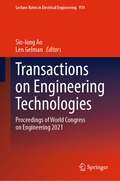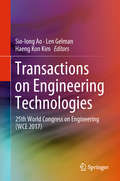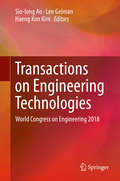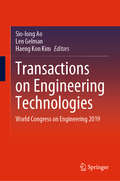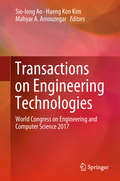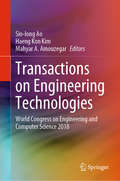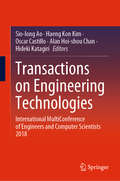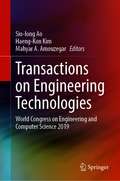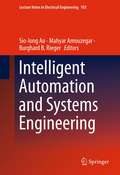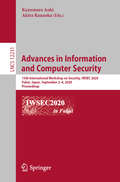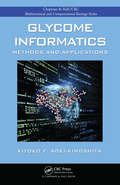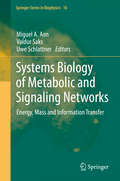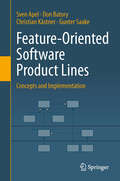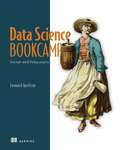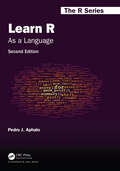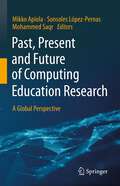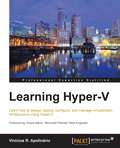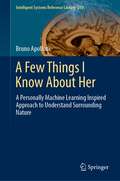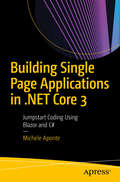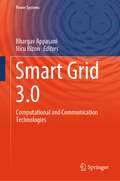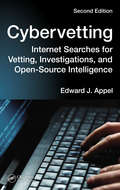- Table View
- List View
Transactions on Engineering Technologies: Proceedings of World Congress on Engineering 2021 (Lecture Notes in Electrical Engineering #919)
by Sio-Iong Ao Len GelmanThis book contains a selection of revised and extended research articles written by prominent researchers participating in the international conference on Advances in Engineering Technologies and Physical Science is held in London, UK, during July 7–9, 2021. This book demonstrates revised and extended research articles written by prominent researchers participating in the conference. Topics covered include mechanical engineering, bioengineering, Internet engineering, image engineering, wireless networks, knowledge engineering, manufacturing engineering, and industrial applications. The book offers the state of the art of tremendous advances in engineering technologies and physical science and applications and also serves as an excellent reference work for researchers and graduate students working with/on engineering technologies and physical science and applications.
Transactions on Engineering Technologies: Special Volume Of The World Congress On Engineering 2013 (Lecture Notes In Electrical Engineering #275)
by Sio-Iong Ao Len Gelman Haeng Kon KimThis volume contains a selection of revised and extended research articles written by prominent researchers participating in a large international conference on Advances in Engineering Technologies and Physical Science which was held in London, UK, 5-7 July, 2017. Topics covered include mechanical engineering, engineering mathematics, computer science, knowledge engineering, electrical engineering, wireless networks, and industrial applications. With contributions carefully chosen to represent the most cutting-edge research presented during the conference, the book offers the state of art in engineering technologies and physical science and applications, and also serves as an excellent reference work for researchers and graduate students working with/on engineering technologies and physical science and applications.
Transactions on Engineering Technologies: World Congress on Engineering 2018 (Lecture Notes In Electrical Engineering Ser. #275)
by Sio-Iong Ao Len Gelman Haeng Kon KimThis volume contains a selection of revised and extended research articles written by prominent researchers participating in The 26th World Congress on Engineering (WCE 2018) which was held in London, U.K., July 4-6, 2018. Topics covered include engineering mathematics, electrical engineering, communications systems, computer science, chemical engineering, systems engineering, manufacturing engineering, and industrial applications. With contributions carefully chosen to represent the most cutting-edge research presented during the conference, the book contains some of the state-of-the-art in engineering technologies and the physical sciences and their applications, and serves as a useful reference for researchers and graduate students working in these fields.
Transactions on Engineering Technologies: World Congress on Engineering 2019 (Lecture Notes In Electrical Engineering Ser. #275)
by Sio-Iong Ao Len Gelman Haeng Kon KimThis book contains a selection of research articles written by prominent researchers participating in The 27th World Congress on Engineering (WCE 2019) which was held in London, UK, July 3–5, 2019. Topics covered include engineering mathematics, electrical engineering, communications systems, computer science, chemical engineering, systems engineering, manufacturing engineering, and industrial applications. With contributions carefully chosen to represent the most cutting-edge research presented during the conference, the book contains some of the state of the art in engineering technologies and the physical sciences and their applications and serves as a useful reference for researchers and graduate students working in these fields.
Transactions on Engineering Technologies: World Congress on Engineering and Computer Science 2017 (Lecture Notes In Electrical Engineering #275)
by Sio-Iong Ao Haeng Kon Kim Mahyar A. AmouzegarThis volume contains a selection of revised and extended research articles written by prominent researchers participating in a large international conference on Advances in Engineering Technologies and Physical Science which was held in San Francisco, California, USA, October 25-27, 2017. Topics covered include engineering mathematics, electrical engineering, communications systems, computer science, chemical engineering, systems engineering, manufacturing engineering, and industrial applications. With contributions carefully chosen to represent the most cutting-edge research presented during the conference, the book contains some of the state-of-the-art in engineering technologies and the physical sciences and their applications, and serves as a useful reference for researchers and graduate students working in these fields.
Transactions on Engineering Technologies: World Congress on Engineering and Computer Science 2018 (Lecture Notes In Electrical Engineering Ser. #275)
by Sio-Iong Ao Haeng Kon Kim Mahyar A. AmouzegarThis book features a selection of revised and extended research articles written by prominent researchers who participated in the 26th World Congress on Engineering and Computer Science (WCECS 2018), held in San Francisco, USA, on October 23–25, 2018. Topics covered include engineering mathematics, electrical engineering, communications systems, computer science, chemical engineering, systems engineering, manufacturing engineering and industrial applications. With contributions carefully chosen to represent the most cutting-edge research presented at the conference and highlighting the state of the art in engineering technologies and the physical sciences and their applications, the book is a valuable reference resource for graduate students and researchers working in these fields.
Transactions on Engineering Technologies: International MultiConference of Engineers and Computer Scientists 2018 (Lecture Notes in Electrical Engineering #275)
by Sio-Iong Ao Haeng Kon Kim Oscar Castillo Alan Hoi-shou Chan Hideki KatagiriThis book contains revised and extended research articles written by prominent researchers, selected from presentations at the International MultiConference of Engineers and Computer Scientists (IMECS 2018) held in Hong Kong, 14-16 March, 2018. Topics covered include engineering physics, communications systems, control theory, automation, engineering mathematics, scientific computing, electrical engineering, and industrial applications. The book gives a snapshot of selected advances in engineering technologies and their applications, and will serve as a useful reference for researchers and graduate students in these fields.
Transactions on Engineering Technologies: World Congress on Engineering and Computer Science 2019 (Lecture Notes In Electrical Engineering Ser. #275)
by Sio-Iong Ao Haeng-Kon Kim Mahyar A. AmouzegarThis book contains a selection of revised and extended research articles written by prominent researchers participating in the 27th World Congress on Engineering and Computer Science (WCECS 2019) which was held in San Francisco, USA, on October 22–24, 2019. Topics covered include engineering mathematics, electrical engineering, communications systems, computer science, chemical engineering, systems engineering, manufacturing engineering, and industrial applications. With contributions carefully chosen to represent the most cutting-edge research presented during the conference, the book contains some of the state-of-the-art in engineering technologies and the physical sciences and their applications and serves as a useful reference for researchers and graduate students working in these fields.
Intelligent Automation and Systems Engineering
by Sio-Iong Ao Burghard B. Rieger Mahyar AmouzegarIntelligent systems are required to facilitate the use of information provided by the internet and other computer based technologies. This book describes the state-of-the-art in Intelligent Automation and Systems Engineering. Topics covered include Intelligent decision making, Automation, Robotics, Expert systems, Fuzzy systems, Knowledge-based systems, Knowledge extraction, Large database management, Data analysis tools, Computational biology, Optimization algorithms, Experimental designs, Complex system identification, Computational modeling, Systems simulation, Decision modeling, and industrial applications.
Advances in Information and Computer Security: 15th International Workshop on Security, IWSEC 2020, Fukui, Japan, September 2–4, 2020, Proceedings (Lecture Notes in Computer Science #12231)
by Kazumaro Aoki Akira KanaokaThis book constitutes the refereed proceedings of the 15th International Workshop on Security, IWSEC 2020, held in Fukui, Japan, in September 2020.* The 15 regular papers and 1 short paper presented in this volume were carefully reviewed and selected from 47 submissions. They were organized in topical sections named: symmetric-key cryptography, malicious activity detection, multiparty computation, post quantum cryptography, privacy, pairing-based cryptography, and machine learning. * The conference was held virtually due to the COVID-19 pandemic.
Glycome Informatics: Methods and Applications (Chapman And Hall/crc Computational Biology Ser.)
by Kiyoko F. Aoki-KinoshitaA Focused, State-of-the-Art Overview of This Evolving FieldPresents Various Techniques for GlycoinformaticsThe development and use of informatics tools and databases for glycobiology and glycomics research have increased considerably in recent years. In addition to accumulating well-structured glyco-related data, researchers have now developed semi
Systems Biology of Metabolic and Signaling Networks
by Miguel A. Aon Valdur Saks Uwe SchlattnerSystems Biology represents a new paradigm aiming at a whole-organism-level understanding of biological phenomena, emphasizing interconnections and functional interrelationships rather than component parts. The study of network properties, and how they control and regulate behavior from the cellular to organism level, constitutes a main focus of Systems Biology. This book addresses from a novel perspective a major unsolved biological problem: understanding how a cell works and what goes wrong in pathology. The task undertaken by the authors is in equal parts conceptual and methodological, integrative and analytical, experimental and theoretical, qualitative and quantitative, didactic and comprehensive. Essentially, they unravel the spatio-temporal unfolding of interacting mass-energy and information networks at the cellular and organ levels, as well as its modulation through activation or repression by signaling networks to produce a certain phenotype or (patho)physiological response. Starting with the historical roots, in thirteen chapters this work explores the Systems Biology of signaling networks, cellular structures and fluxes, organ and microorganism functions. In doing so, it establishes the basis of a 21st century approach to biological complexity.
The Legend of Zelda: Hyrule Historia
by Eiji Aonuma Akira HimekawaMake sure to check out the other installments in this unparalleled collection of historical information on The Legend of Zelda franchise with the New York Times best selling The Legend of Zelda: Art & Artifacts and The Legend of Zelda: Encyclopedia. Also look for The Legend of Zelda: Breath of the Wild — Creating a Champion for an indepth look at the art, lore, and making of the best selling video game! Dark Horse Books and Nintendo team up to bring you The Legend of Zelda: Hyrule Historia, containing an unparalleled collection of historical information on The Legend of Zelda franchise. This handsome digital book contains never-before-seen concept art, the full history of Hyrule, the official chronology of the games, and much more! Starting with an insightful introduction by the legendary producer and video-game designer of Donkey Kong, Mario, and The Legend of Zelda, Shigeru Miyamoto, this book is crammed full of information about the storied history of Link's adventures from the creators themselves! As a bonus, The Legend of Zelda: Hyrule Historia includes an exclusive comic by the foremost creator of The Legend of Zelda manga — Akira Himekawa!
Feature-Oriented Software Product Lines
by Sven Apel Don Batory Christian Kästner Gunter SaakeWhile standardization has empowered the software industry to substantially scale software development and to provide affordable software to a broad market, it often does not address smaller market segments, nor the needs and wishes of individual customers. Software product lines reconcile mass production and standardization with mass customization in software engineering. Ideally, based on a set of reusable parts, a software manufacturer can generate a software product based on the requirements of its customer. The concept of features is central to achieving this level of automation, because features bridge the gap between the requirements the customer has and the functionality a product provides. Thus features are a central concept in all phases of product-line development. The authors take a developer's viewpoint, focus on the development, maintenance, and implementation of product-line variability, and especially concentrate on automated product derivation based on a user's feature selection. The book consists of three parts. Part I provides a general introduction to feature-oriented software product lines, describing the product-line approach and introducing the product-line development process with its two elements of domain and application engineering. The pivotal part II covers a wide variety of implementation techniques including design patterns, frameworks, components, feature-oriented programming, and aspect-oriented programming, as well as tool-based approaches including preprocessors, build systems, version-control systems, and virtual separation of concerns. Finally, part III is devoted to advanced topics related to feature-oriented product lines like refactoring, feature interaction, and analysis tools specific to product lines. In addition, an appendix lists various helpful tools for software product-line development, along with a description of how they relate to the topics covered in this book. To tie the book together, the authors use two running examples that are well documented in the product-line literature: data management for embedded systems, and variations of graph data structures. They start every chapter by explicitly stating the respective learning goals and finish it with a set of exercises; additional teaching material is also available online. All these features make the book ideally suited for teaching - both for academic classes and for professionals interested in self-study.
Data Science Bookcamp: Five real-world Python projects
by Leonard ApeltsinLearn data science with Python by building five real-world projects! Experiment with card game predictions, tracking disease outbreaks, and more, as you build a flexible and intuitive understanding of data science.In Data Science Bookcamp you will learn: - Techniques for computing and plotting probabilities - Statistical analysis using Scipy - How to organize datasets with clustering algorithms - How to visualize complex multi-variable datasets - How to train a decision tree machine learning algorithm In Data Science Bookcamp you&’ll test and build your knowledge of Python with the kind of open-ended problems that professional data scientists work on every day. Downloadable data sets and thoroughly-explained solutions help you lock in what you&’ve learned, building your confidence and making you ready for an exciting new data science career. Purchase of the print book includes a free eBook in PDF, Kindle, and ePub formats from Manning Publications. About the technology A data science project has a lot of moving parts, and it takes practice and skill to get all the code, algorithms, datasets, formats, and visualizations working together harmoniously. This unique book guides you through five realistic projects, including tracking disease outbreaks from news headlines, analyzing social networks, and finding relevant patterns in ad click data. About the book Data Science Bookcamp doesn&’t stop with surface-level theory and toy examples. As you work through each project, you&’ll learn how to troubleshoot common problems like missing data, messy data, and algorithms that don&’t quite fit the model you&’re building. You&’ll appreciate the detailed setup instructions and the fully explained solutions that highlight common failure points. In the end, you&’ll be confident in your skills because you can see the results. What's inside - Web scraping - Organize datasets with clustering algorithms - Visualize complex multi-variable datasets - Train a decision tree machine learning algorithm About the reader For readers who know the basics of Python. No prior data science or machine learning skills required. About the author Leonard Apeltsin is the Head of Data Science at Anomaly, where his team applies advanced analytics to uncover healthcare fraud, waste, and abuse. Table of Contents CASE STUDY 1 FINDING THE WINNING STRATEGY IN A CARD GAME 1 Computing probabilities using Python 2 Plotting probabilities using Matplotlib 3 Running random simulations in NumPy 4 Case study 1 solution CASE STUDY 2 ASSESSING ONLINE AD CLICKS FOR SIGNIFICANCE 5 Basic probability and statistical analysis using SciPy 6 Making predictions using the central limit theorem and SciPy 7 Statistical hypothesis testing 8 Analyzing tables using Pandas 9 Case study 2 solution CASE STUDY 3 TRACKING DISEASE OUTBREAKS USING NEWS HEADLINES 10 Clustering data into groups 11 Geographic location visualization and analysis 12 Case study 3 solution CASE STUDY 4 USING ONLINE JOB POSTINGS TO IMPROVE YOUR DATA SCIENCE RESUME 13 Measuring text similarities 14 Dimension reduction of matrix data 15 NLP analysis of large text datasets 16 Extracting text from web pages 17 Case study 4 solution CASE STUDY 5 PREDICTING FUTURE FRIENDSHIPS FROM SOCIAL NETWORK DATA 18 An introduction to graph theory and network analysis 19 Dynamic graph theory techniques for node ranking and social network analysis 20 Network-driven supervised machine learning 21 Training linear classifiers with logistic regression 22 Training nonlinear classifiers with decision tree techniques 23 Case study 5 solution
Learn R: As a Language (Chapman & Hall/CRC The R Series)
by Pedro J. AphaloLearning a computer language like R can be either frustrating, fun or boring. Having fun requires challenges that wake up the learner’s curiosity but also provide an emotional reward for overcoming them. The book is designed so that it includes smaller and bigger challenges, in what I call playgrounds, in the hope that all readers will enjoy their path to R fluency. Fluency in the use of a language is a skill that is acquired through practice and exploration. For students and professionals in the biological sciences, humanities and many applied fields, recognizing the parallels between R and natural languages should help them feel at home with R. The approach I use is similar to that of a travel guide, encouraging exploration and describing the available alternatives and how to reach them. The intention is to guide the reader through the R landscape of 2024 and beyond.What is new in the second edition? Text expanded by more than 25% to include additional R features and gentler and more detailed explanations Contains 24 new diagrams and flowcharts, seven new tables, and revised text and code examples for clarity All three indexes were expanded, and answers to 28 frequently asked questions added What will you find in this book? Programming concepts explained as they apply to current R Emphasis on the role of abstractions in programming Few prescriptive rules—mostly the author’s preferences together with alternatives Presentation of the R language emphasizing the “R way of doing things” Tutoring for “programming in the small” using scripts for data analysis Explanation of the differences between R proper and extensions for data wrangling The grammar of graphics is described as a language for the construction of data visualisations Examples of data exchange between R and the foreign world using common file formats Coaching to become an independent R user, capable of writing original scripts and solving future challenges
Past, Present and Future of Computing Education Research: A Global Perspective
by Mikko Apiola Sonsoles López-Pernas Mohammed SaqrThis book presents a collection of meta-studies, reviews, and scientometric analyses that together reveal a fresh picture about the past, present, and future of computing education research (CER) as a field of science. The book begins with three chapters that discuss and summarise meta-research about the foundations of CER, its disciplinary identity, and use of research methodologies and theories. Based on this, the book proceeds with several scientometric analyses, which explore authors and their collaboration networks, dissemination practices, international collaboration, and shifts in research focus over the years. Analyses of dissemination are deepened in two chapters that focus on some of the most influential publication venues of CER. The book also contains a series of country-, or region-level analyses, including chapters that focus on the evolution of CER in the Baltic Region, Finland, Australasia, Israel, and in the UK & Ireland. Two chapters present case studies of influential CER initiatives in Sweden and Namibia. This book also includes chapters that focus on CER conducted at school level, and cover crucially important issues such as technology ethics, algorithmic bias, and their implications for CER.In all, this book contributes to building an understanding of the past, present and future of CER. This book also contributes new practical guidelines, highlights topical areas of research, shows who to connect with, where to publish, and gives ideas of innovative research niches. The book takes a unique methodological approach by presenting a combination of meta-studies, scientometric analyses of publication metadata, and large-scale studies about the evolution of CER in different geographical regions. This book is intended for educational practitioners, researchers, students, and anyone interested in CER. This book was written in collaboration with some of the leading experts of the field.
Learning Hyper-V
by Vinicius R. ApolinarioThis book focuses on readers starting their journey with Hyper-V, and assumes they have minimal or no knowledge of virtualization.
A Few Things I Know About Her: A Personally Machine Learning Inspired Approach to Understand Surrounding Nature (Intelligent Systems Reference Library #219)
by Bruno ApolloniThis book reconsiders key issues, such as description and explanation, which affect data analytics. For starters: the soul does not exist. Once released from this cumbersome roommate, we are left with complex biological systems: namely, ourselves, who must configure their environment in terms of worlds that are compatible with what they sense. Far from supplying yet another cosmogony, the book provides the cultivated reader with computational tools for describing and understanding data arising from his surroundings, such as climate parameters or stock market trends, even the win/defeat story of his son football team. Besides the superposition of the very many universes considered by quantum mechanics, we aim to manage families of worlds that may have generated those data through the key feature of their compatibility. Starting from a sharp engineering of ourselves in term of pairs consisting of genome plus a neuron ensemble, we toss this feature in different cognitive frameworks within a span of exploitations ranging from probability distributions to the latest implementations of machine learning. From the perspective of human society as an ensemble of the above pairs, the book also provides scientific tools for analyzing the benefits and drawbacks of the modern paradigm of the world as a service.
Building Single Page Applications in .NET Core 3: Jumpstart Coding Using Blazor and C#
by Michele AponteAttention .NET developers who no longer want to use JavaScript for your front end. Quickly and efficiently learn how to use C# for your single-page application (SPA) thanks to Blazor. Today’s reality is that most modern applications are web-based and if you want the same user experience as a desktop application, you need to be able to create a single-page application. While there are multiple frameworks and libraries to choose from (including Angular, React, and VueJS), you still need to know how to code in JavaScript. But now there is another option from Microsoft. Blazor is an open-source framework that enables developers to create web applications using C# and HTML, and everything you need to get started is covered in this guide. You will learn the steps, through build-along coding examples, that will allow you to use the same language for both the front end and the back end of your application. This book is designed to get you comfortable creating a single-page application in the shortest time possible. Get ready to create a complete business application that teaches and reinforces the skills you need in a Blazor production environment.What You Will Learn Develop the front end of an application using C# and .NET Core Use this quick-start for .NET developers who need to improve their application with a single-page front end Take a code-first approach that models an actual business application Gain insights for developing a high-functioning and maintainable applicationStudy guidance on repurposing your .NET skill setWho This Book Is ForC# and .NET developers who have some experience in web development
Smart Grid 3.0: Computational and Communication Technologies (Power Systems)
by Bhargav Appasani Nicu BizonThis book is the first on Smart Grid 3.0.The book presents literature reviews of recent computational and communication technologies and their application in the evolution of smart grids to Smart Grid 3.0. It offers new control solutions, architectures and energy management strategies that are based on artificial intelligence and deep learning techniques.The book details the hardware and software implementation of fault identification or detection based on synchrophasor data and machine learning. It also discusses blockchain architectures for smart grid applications such as electric vehicles, home automation and automatic metering infrastructure.
Compiling with Continuations
by Andrew W. AppelThe control and data flow of a program can be represented using continuations, a concept from denotational semantics that has practical application in real compilers. This book shows how continuation-passing style is used as an intermediate representation on which to perform optimizations and program transformations. Continuations can be used to compile most programming languages. The method is illustrated in a compiler for the programming language Standard ML. However, prior knowledge of ML is not necessary, as the author carefully explains each concept as it arises. This is the first book to show how concepts from the theory of programming languages can be applied to the producton of practical optimizing compilers for modern languages like ML. This book will be essential reading for compiler writers in both industry and academe, as well as for students and researchers in programming language theory.
Modern Compiler Implementation in C
by Andrew W. AppelThis new, expanded textbook describes all phases of a modern compiler: lexical analysis, parsing, abstract syntax, semantic actions, intermediate representations, instruction selection via tree matching, dataflow analysis, graph-coloring register allocation, and runtime systems. It includes good coverage of current techniques in code generation and register allocation, as well as functional and object-oriented languages, that are missing from most books. In addition, more advanced chapters are now included so that it can be used as the basis for a two-semester or graduate course. The most accepted and successful techniques are described in a concise way, rather than as an exhaustive catalog of every possible variant. Detailed descriptions of the interfaces between modules of a compiler are illustrated with actual C header files. The first part of the book, Fundamentals of Compilation, is suitable for a one-semester first course in compiler design. The second part, Advanced Topics, which includes the advanced chapters, covers the compilation of object-oriented and functional languages, garbage collection, loop optimizations, SSA form, loop scheduling, and optimization for cache-memory hierarchies.
Modern Compiler Implementation in Java Second Edition
by Andrew W. Appel Jens PalsbergThis textbook describes all phases of a compiler: lexical analysis, parsing, abstract syntax, semantic actions, intermediate representations, instruction selection via tree matching, dataflow analysis, graph-coloring register allocation, and runtime systems. It includes thorough coverage of current techniques in code generation and register allocation, and the compilation of functional and object-oriented languages. The most accepted and successful techniques are described and illustrated with actual Java^TM® classes. The first part is suitable for a one-semester first course in compiler design. The second part; which includes the compilation of object-oriented and functional languages, garbage collection, loop optimization, SSA form, instruction scheduling, and optimization for cache-memory hierarchies; can be used for a second-semester or graduate course. This new edition includes more discussion of Java and object-oriented programming concepts such as visitor patterns plus a new Mini-Java programming project. A unique feature is the newly redesigned compiler project in Java for a subset of Java itself. The project includes both front-end and back-end phases.
Cybervetting: Internet Searches for Vetting, Investigations, and Open-Source Intelligence, Second Edition
by Edward J. AppelResearching an individual‘s, firm‘s or brands online presence has become standard practice for many employers, investigators, and intelligence officers, including law enforcement. Countless companies and organizations are implementing their own policies, procedures, and practices for Internet investigations, cybervetting, and intelligence.
